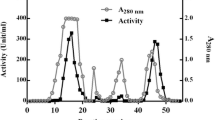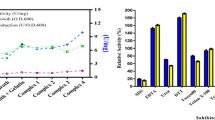Abstract
An extremely halophilic archaeon Haloferax lucentensis VKMM 007, isolated from a solar saltern, was found to produce a protease. This extracellular enzyme consisted of a single polypeptide chain of 57.8 kDa as determined by SDS–PAGE and was purified by a combination of ultrafiltration, bacitracin–Sepharose affinity chromatography and Sephadex G-100 gel filtration. The purified protein was stable in a wide range of temperatures (20–70°C), NaCl concentrations (0.85–5.13 M) and pH (5.0–9.0) with maximal activity observed at 60°C, 4.3 M NaCl and pH 8.0. Proteolytic activity was enhanced by Ca2+, K+, Mg2+, Na+, and Fe2+ ions and the protein was classified as a trypsin-like serine protease. Further assays indicated highest degree of specificity when hemoglobin was used as an enzyme substrate. Most importantly, the proteolytic activity remained stable or only marginally inhibited in the presence of various polar and non-polar solvents, surfactants and reducing agents thus emphasizing the biotechnological potential of this novel halophilic protease.





Similar content being viewed by others
References
Akolkar AV, Deshpande GM, Raval KN, Durai D, Nerurkar AS, Desai AJ (2008) Organic solvent tolerance of Halobacterium sp. SP1(1) and its extracellular protease. J Basic Microbiol 48:421–425
Blum H, Beier H, Gross HJ (1987) Improved silver staining of plant proteins, RNA and DNA in polyacrylamide gels. Electrophoresis 8:93–99
Bohm G, Jaenicke R (1994) Relevance of sequence statistics for the properties of extremophilic proteins. Int J Pept Protein Res 43:97–106
Bradford MM (1976) A rapid and sensitive method for quantitation of microgram quantities of protein utilizing the principle of protein-dye binding. Anal Biochem 72:248–254
De Castro RE, Maupin-Furlow JA, Gimenez M, Seitz MH, Sanchez JJ (2006) Haloarchaeal proteases and proteolytic systems. FEMS Microbiol Rev 30:17–35
Ghorbel B, Kamoun AS, Nasri M (2003) Stability studies of protease from Bacillus cereus BG1. Enzyme Microb Tech 32:513–518
Giménez MI, Studdert CA, Sánchez JJ, De Castro RE (2000) Extracellular protease of Natrialba magadii: purification and biochemical characterization. Extremophiles 4:181–188
Gutierrez MC, Kamekura M, Holmes ML, Dyall-Smith ML, Ventosa A (2002) Taxonomic characterization of Haloferax sp. (“H. alicantei”) strain Aa 2.2: description of Haloferax lucentensis sp. nov. Extremophiles 6:479–483
Izotova LS, Strongin AY, Chekulaeva LW, Sterkin VE, Ostoslavskaya VI, Lyublinskaya EA, Timokhina EA, Stepanov VM (1983) Purification and properties of serine protease from Halobacterium halobium. J Bacteriol 155:826–830
Jimenez CR, Huang L, Qiu Y, Burlingame AL (1998) Sample preparations for MALDI mass analysis of peptides and proteins. In: Coligan JE, Dunn BM, Ploogh HL, Speicher DW, Wingfield PT (eds) Current protocols in protein science, vol 1. Wiley, NY
Joo WA, Kim CW (2005) Proteomics of halophilic archaea. J Chromatogr B Analyt Technol Biomed Life Sci 815:237–250
Kamekura M, Seno Y (1990) A halophilic extracellular proteasefrom a halophilic archaebacterium strain 172P1. Biochem Cell Biol 68:352–359
Kamekura M, Seno Y, Holmes ML, Dyall-Smith ML (1992) Molecular cloning and sequencing of the gene for a halophilic alkaline serine protease (halolysin) from an unidentified halophilic archaea strain (172P1) and expression of the gene in Haloferax volcanii. J Bacteriol 174:736–742
Kamekura M, Seno Y, Dyall-Smith ML (1996) Halolysin R4, a serine proteinase from the halophilic archaeon Haloferax mediterranei; gene cloning, expression and structural studies. Biochim Biophys Acta 1294:159–167
Klibanov AM (2001) Improving enzymes by using them in organic solvents. Nature 409:241–246
Kim J, Dordick JS (1997) Unusual salt and solvent dependence of a protease from an extreme halophile. Biotechnol Bioeng 55:471–479
Lanyi JK (1974) Salt-dependent properties of proteins from extremely halophilic bacteria. Bacteriol Rev 38:272–290
Madern D, Ebel C, Zaccai G (2000) Halophilic adaptation of enzymes. Extremophiles 4:91–98
Manikandan M, Pašić L, Kannan V (2009) Optimization of growth media for obtaining high-cell density cultures of halophilic archaea (family Halobacteriaceae) by response surface methodology. Bioresour Technol 100:3107–3112
Margesin R, Schiner F (2001) Potential of halotolerant and halophilic microorganisms for biotechnology. Extremophiles 5:73–83
Maurer KH (2004) Detergent proteases. Curr Opin Biotechnol 15:330–334
McDonald CE, Chen LL (1965) The Lowry modification of the folin reagent for determination of proteinase activity. Anal Biochem 10:175–177
Nolasco H, Kushner DJ, Ochoa JL (2002) Purification and properties of an extracellular halophilic serine-protease from Haloferax mediterranei. J Mex Chem Soc 46:202–211
Pašić L, Herzog Velikonja B, Poklar Ulrih N (2008) Optimization of the culture conditions for the production of a bacteriocin from halophilic archaeon Sech7a. Prep Biochem Biotechnol 38:229–245
Rao MB, Tanksale AM, Ghatge MS, Deshpande VV (1998) Molecular and biotechnological aspects of microbial proteases. Microbiol Mol Biol Rev 62:597–635
Ruiz DM, De Castro RE (2007) Effect of organic solvents on the activity and stability of an extracellular protease secreted by the haloalkaliphilic archaeon Natrialba magadii. J Ind Microbiol Biotechnol 34:111–115
Ryu K, Kim J, Dordick JS (1994) Catalytic properties and potential of an extracellular protease from an extreme halophile. Enzyme Microb Tech 16:266–275
Serdakowski AL, Dordick JS (2008) Activating enzymes for use with organic solvents. In: Carrea G, Riva S (eds) Organic synthesis with enzymes in non-aqueous media. Wiley, New York, pp 47–75
Shi WL, Zhong CQ, Tang B, Shen P (2007) Purification and characterization of extracellular halophilic protease from Natrinema sp. R6–5. Wei Sheng Wu Xue Bao 47:161–163
Stan-Lotter H, Doppler E, Jarosh M, Radax C, Gruber C, Inatomi KI (1999) Isolation of a chymotrypsinogen B-like enzyme from the archaeon Natronomonas pharaonis and other halobacteria. Extremophiles 3:153–161
Stepanov VM, Rudenskaya GN (1983) Proteinase affinity chromatography on bacitracin–Sepharose. J Appl Biochem 5:420–428
Stepanov VM, Rudenskaya GN, Revina LP, Gryaznova YB, Lysogorskaya EN, Filippova IY, Ivanova II (1992) A serine proteinase of archaebacterium, Halobacterium mediterranei, a homologue of an eubacterial subtilisin. Biochem J 285:281–286
Studdert CA, De Castro RE, Herrera Seitz MK, Sanchez JJ (1997) Detection and preliminary characterization of extracellular proteolytic activities of the haloalkaliphilic archaeon Natronococcus occultus. Arch Microbiol 168:532–535
Studdert CA, Herrera Seitz MK, Plasencia Gil MI, Sanchez JJ, De Castro RE (2001) Purification, biochemical characterization of the haloalkaliphilic archeon Natronococcus occultus extracellular serine protease. J Basic Microbiol 41:375–383
Thongthai C, Gildberg A (2005) Asian fish sauce as a source of nutrition. In: Shahidi F, Ho C (eds) Asian functional foods. CRC press, USA, pp 215–267
Vidyasagar M, Prakash S, Litchfield C, Sreeramulu K (2006) Purification and characterization of a thermostable, haloalkaliphilic extracellular serine protease from the extreme halophilic archaeon Halogeometricum borinquense strain TSS101. Archaea 2:51–57
Wolz RL (1999) Strategies for inhibiting proteases of unknown mechanism. In: Sterchi EE, Stöcker W (eds) Proteolytic enzymes tools and targets. Springer, New York, pp 90–108
Acknowledgments
This work was supported by a grant from Government of India Ministry of Science and Technology, Department of Biotechnology to Centre for Advanced studies in Botany, University of Madras (MM, VK) and Slovenian Research Agency research programme P1-0198 (LP).
Author information
Authors and Affiliations
Corresponding author
Rights and permissions
About this article
Cite this article
Manikandan, M., Pašić, L. & Kannan, V. Purification and biological characterization of a halophilic thermostable protease from Haloferax lucentensis VKMM 007. World J Microbiol Biotechnol 25, 2247–2256 (2009). https://doi.org/10.1007/s11274-009-0132-1
Received:
Accepted:
Published:
Issue Date:
DOI: https://doi.org/10.1007/s11274-009-0132-1




